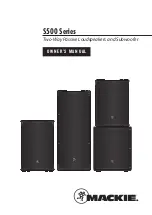
4 Equalization and tuning
Ray-On loudspeakers may be used without any equalization, but using one is advised. Equalization flattens the
column’s frequency response and protects the loudspeakers by filtering low frequencies.
Two equalizations are specified:
• one for speech, which uses 4 cells (n°2-5);
• the other for music, which uses 6 cells (n°1-6).
The table
2
gives detailed information about these equalizations.. The corresponding frequency curves are pre-
sented in figure
1
.
Type
Paramètres
1
Parametric
Freq = 100 Hz ; Gain = +6 dB ; Width = 1.5 oct (Q=0.92)
2
2nd order high-pass
Fcut = 130 Hz ; -3dB @ Fcut (Butterworth)
3
Parametric
Freq = 190 Hz ; Gain = -3.0 dB ; Width = 0.4 oct (Q=3.6)
4
High-Shelv
Freq = 1800 Hz ; Gain = -5.0 dB
5
Parametric
Freq = 3600 Hz ; Gain = +5 dB ; Width = 0.5 oct (Q=1.3)
6
Parametric
Freq = 15 500 Hz ; Gain = +6.0 dB ; Width = 0.5 oct (Q=1.2)
Table 2 – Recommended equalization. Voice: cells 2-5. Music: cells 1-6.
If a subwoofer is used, it is advised not to activate the cell 1, frequencies under 180Hz being rendered by the sub.
This allows the columns to not be driven with important levels of low frequencies.
10
2
10
3
10
4
−
20
−
15
−
10
−
5
0
5
10
Figure 1 – Recommended equalization curve with (red) and without (blue) cells n°1 and n°6.
5






























